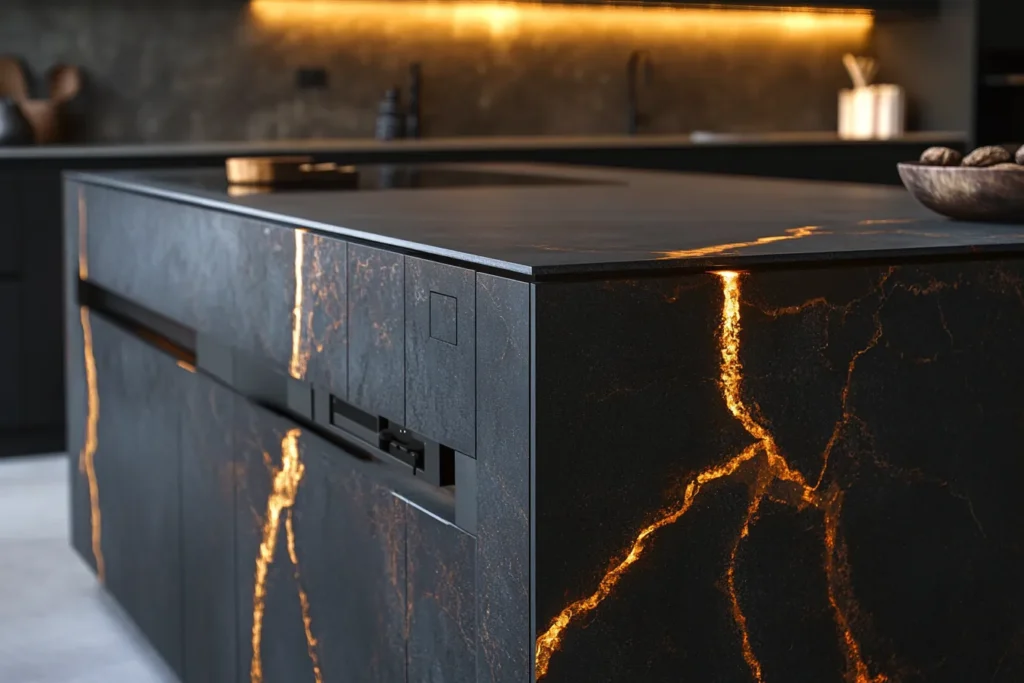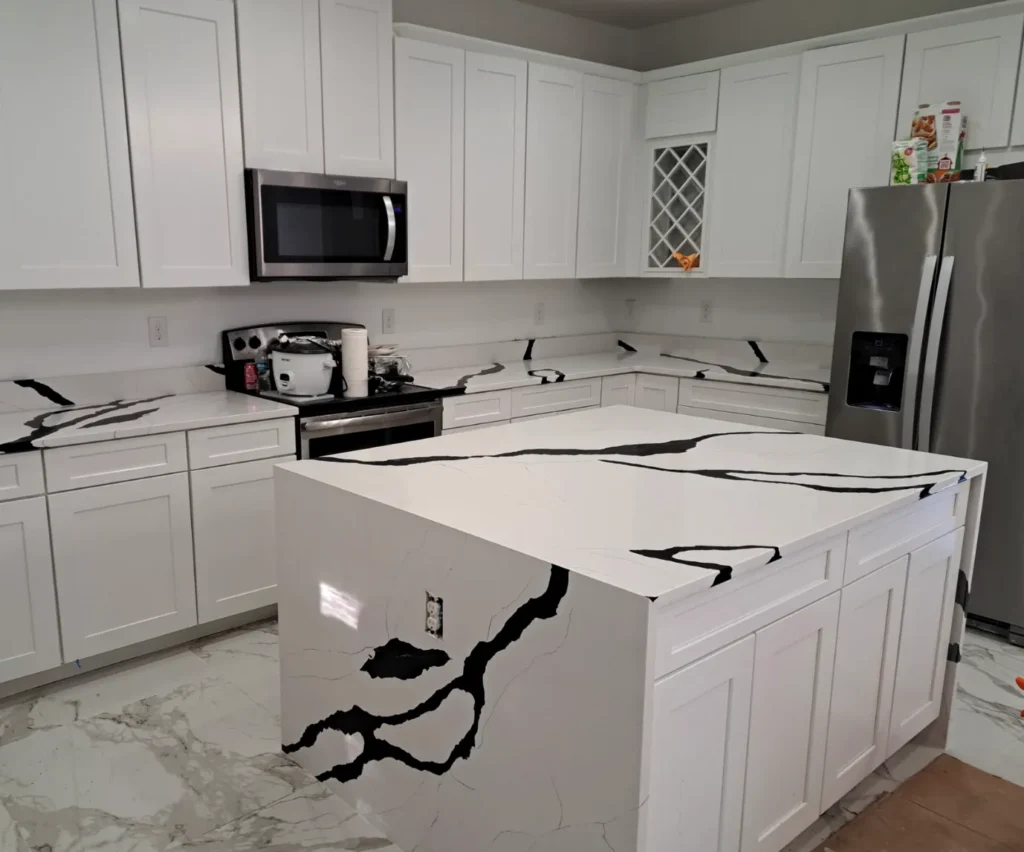The kitchen, once a purely utilitarian space, has evolved into the undisputed heart of the modern home—a stage for culinary creativity, a hub for family gatherings, and a significant statement of personal style. As we look towards 2025, the design landscape is dominated by a captivating tension: the desire for show-stopping aesthetics, epitomized by the sculptural beauty of waterfall stone islands, and the non-negotiable need for seamless functionality. Today’s discerning homeowners and the designers who guide them are no longer choosing between form and function; they are demanding both, in exquisite harmony.
The waterfall island, with its continuous flow of stone cascading from countertop to floor, is a prime example of this trend. It’s a bold architectural gesture, a luxurious centerpiece that anchors the kitchen and elevates its design language. Yet, beneath this sleek veneer lies a world of practical considerations. How do we incorporate essential storage without marring those clean lines? How do we integrate the technology that modern life demands—power outlets, charging stations—without disrupting the monolithic elegance of the stone? And how do we achieve this high-impact look while navigating the realities of material properties, budget, and structural integrity?
The answer lies in clever design, innovative products, and a meticulous approach to planning. The 2025 kitchen is a masterclass in sophisticated concealment and intelligent integration. It’s where the drama of a Calacatta marble waterfall edge meets the quiet efficiency of a touch-to-open drawer, where the unbroken expanse of a quartz island discreetly houses a pop-up charging station. This synergy doesn’t happen by accident; it’s the result of a design philosophy that views beauty and utility as two sides of the same coin. This article delves into the strategies and solutions that bring this vision to life, transforming the kitchen island from a mere work surface into a multi-functional marvel of modern design.
Hidden Storage Under the Island: The Art of Sophisticated Concealment
The visual impact of a waterfall island is undeniable, but its success hinges on what you don’t see. Preserving those sleek, uninterrupted lines requires a strategic approach to storage, moving beyond conventional cabinetry to embrace solutions that are both ingenious and invisible. The goal is to maximize utility while maintaining a minimalist facade, ensuring that every pot, pan, and utensil has its place, yet nothing detracts from the island’s sculptural presence.
Toe-Kick Drawers: Unlocking Wasted Space
Often overlooked, the space beneath the base cabinets—the toe kick—offers a surprising amount of storage potential. Traditionally a recessed void, this area can be transformed with shallow drawers perfect for stowing away items used less frequently, such as serving platters, seasonal linens, baking sheets, or even a discreetly stored step stool.
- Mechanism: Typically operating on a push-to-open mechanism or a subtle, integrated finger pull, these drawers glide out smoothly, revealing their contents without the need for visible hardware.
- Design Integration: When designing a waterfall island, the toe-kick drawer front can be clad in the same material as the cabinetry or a contrasting finish that recedes visually. The key is precision; the drawer must align perfectly with the surrounding elements to maintain the illusion of a solid plinth. For islands with waterfall ends, the toe-kick treatment needs careful consideration to ensure it either wraps consistently or terminates cleanly against the stone panel.
Seamless Toe-Kick Integration: For the ultimate hidden toe-kick drawer, especially with handleless cabinetry, specify a touch-latch system and ensure the drawer front is set with minimal shadow gaps. When the waterfall panel meets the floor, discuss with your fabricator how the toe-kick line will be resolved to avoid an awkward visual break.
Deep Under-Counter Cabinets: Maximizing Volume
The primary storage workhorses within an island are its under-counter cabinets. To make the most of this space, especially in large islands, depth is your ally.
- Full-Extension Drawers: Prioritize deep, full-extension drawers over standard cabinets with shelves. Drawers bring the contents to you, eliminating the need to rummage in dark recesses and making every inch of space accessible. Consider drawer-within-a-drawer systems for layered organization—a shallow inner drawer for cutlery or utensils atop a deeper drawer for pots and pans.
- Pull-Out Pantries: For narrower sections of the island, or at the end opposite the seating overhang, tall, narrow pull-out pantry units can provide surprisingly capacious storage for spices, oils, or cleaning supplies.
- Appliance Garages with Pocket Doors: While not strictly “under-counter,” if the island design incorporates a slightly raised section or a back panel, an appliance garage with pocket or flipper doors can hide away toasters, blenders, and coffee makers, keeping the main countertop clear.
Caption Suggestion for an Image/Diagram:
A diagram showcasing a cutaway view of a waterfall island. Annotations point to: 1. Toe-kick drawer with push-to-open mechanism. 2. Deep, full-extension pot drawer. 3. Internal divider system within a drawer. 4. Pull-out narrow spice rack at the island’s end.
Push-to-Open and Handleless Mechanisms: The Minimalist’s Dream
The quest for clean lines culminates in the elimination of visible hardware. Push-to-open (or touch-latch) mechanisms are essential for achieving this. A gentle press on the drawer or cabinet front is all it takes to release the latch and allow it to spring open.
- Considerations: While aesthetically superior for minimalist designs, these mechanisms require precision installation. The sensitivity of the latches and the weight of the drawer or door front must be perfectly balanced. For very wide or heavy drawers, multiple latches may be needed.
- Integrated Handles: An alternative is the integrated or channel handle, where a recessed channel is routed into the top or side edge of the drawer/door front. This provides a grip without protruding hardware, maintaining a sleek profile. This can be particularly effective when the channel is lined with a contrasting material or a metallic finish that complements the stone.
The beauty of these hidden storage solutions lies in their subtlety. They allow the grandeur of the waterfall island to take center stage, unencumbered by visual clutter, while ensuring that every practical need is met with effortless efficiency.

Integrating Electrical Pop-Ups Seamlessly: Powering the Modern Island
In an era where technology is interwoven into the fabric of daily life, the kitchen island is no longer just a surface for food preparation; it’s a charging station for devices, a workstation for laptops, and a hub for small appliances. The challenge for designers is to incorporate these essential power sources into a stone island without compromising its aesthetic integrity. The solution lies in a range of discreet, retractable, and flush-mounted electrical units that appear when needed and vanish when not.
The Rise of Retractable Power Towers
One of the most popular solutions for bringing power to an island countertop is the retractable power tower or pop-up socket.
- Functionality: These cylindrical or rectangular units are installed flush with the countertop. With a gentle press, they rise smoothly, revealing multiple standard outlets, USB-A and USB-C ports, and sometimes even wireless charging pads on their top surface. When not in use, they retract back into the island, leaving only a discreet, often metallic, cap visible.
- Installation Considerations: Cutting into a stone countertop, especially premium materials like marble, quartz, or granite, requires precision. The hole for the pop-up unit must be perfectly templated and cut by the stone fabricator, often using waterjet technology, to prevent chipping or cracking. It’s crucial to select the pop-up unit before the stone is fabricated. The depth of the unit also needs to be accommodated within the island’s structure, ensuring it doesn’t interfere with drawers or other components below.
- Aesthetics: Look for units with finishes that complement your stone and fixtures—stainless steel, black, brass, or even custom-matched colors are available. Some high-end models offer a very minimal visible edge when closed.
Waterproofing and Safety: When selecting pop-up outlets for a kitchen island, ensure they are rated for kitchen use and have some degree of water ingress protection (IP rating), especially if they are near a prep sink. Always consult with a qualified electrician for installation.
Flush-Mounted Outlets and Wireless Charging
For an even more minimal approach, flush-mounted outlets and under-mount wireless chargers offer near invisibility.
- Flush Outlets: These are designed to sit perfectly level with the countertop surface. Some feature covers made from the same stone material as the island, rendering them almost undetectable when not in use. Others might have a sleek metallic or colored trim. They often require a more complex installation process to achieve the seamless finish.
- Under-Mount Wireless Charging: This is the epitome of discreet tech integration. A wireless charging transmitter is installed beneath the stone countertop. A subtle etching or a small, inlaid marker on the surface indicates the charging zone. Phones or other compatible devices can then be charged simply by placing them on this spot. This solution completely eliminates any visible clutter on the countertop.
- Stone Compatibility: The effectiveness of under-mount wireless charging can depend on the thickness and density of the stone. It’s essential to verify compatibility with your chosen stone material and the charger manufacturer’s specifications. Thicker slabs might require a section to be milled slightly thinner from underneath to ensure optimal charging performance.
Caption Suggestion for an Image/Diagram:
A close-up shot of a sleek, dark quartz waterfall island. One section shows a pop-up power tower in its raised position, with a phone plugged into a USB port. Another area subtly highlights an etched circle on the stone, indicating an under-mount wireless charging spot.
Strategic Placement: Function Meets Flow
The location of these power sources is as important as their design. Consider how the island will be used:
- Prep Zones: Outlets for small appliances (mixers, blenders) should be conveniently located in primary food preparation areas.
- Seating Areas: If the island includes an overhang for seating, incorporating USB ports or outlets on the side of the island base, or even within a pop-up on the main surface accessible from the seating area, is a thoughtful touch for charging phones and laptops.
- Avoiding Visual Clutter: Even with pop-ups, try to position them away from the primary sightlines if possible, perhaps towards one end of the island or on the “working” side rather than the side facing the main living area.
By thoughtfully integrating these modern conveniences, designers can ensure that the stone island is not just a beautiful focal point but also a highly functional command center for the contemporary kitchen, ready to power every culinary adventure and daily task.





